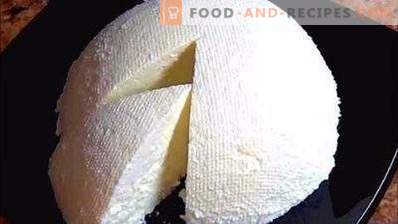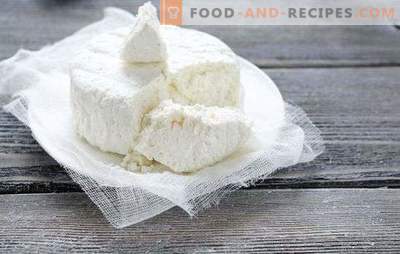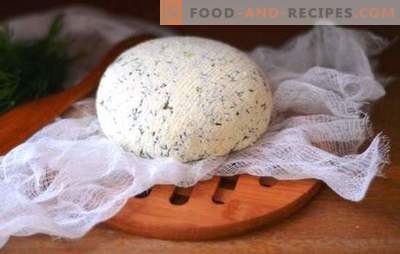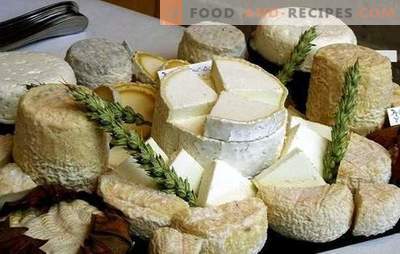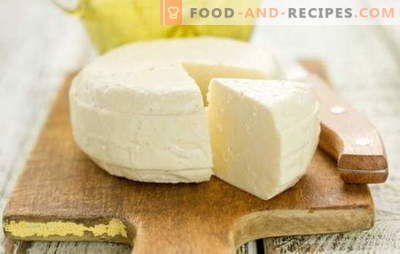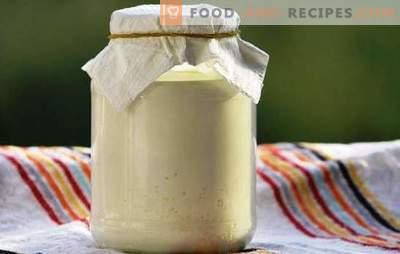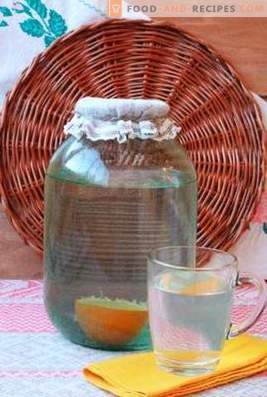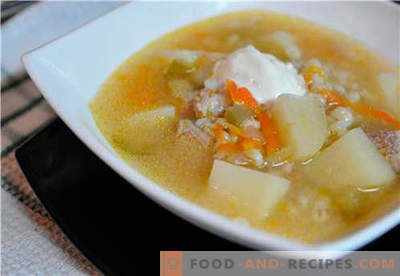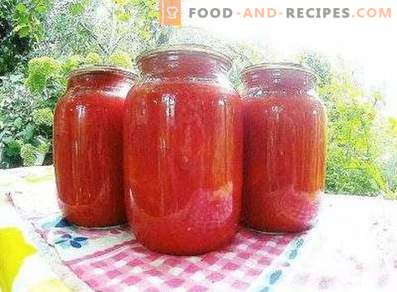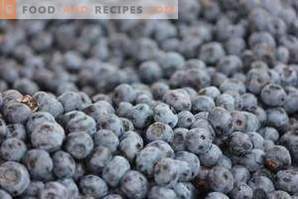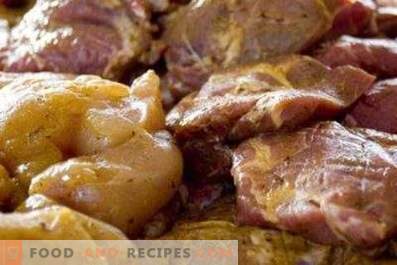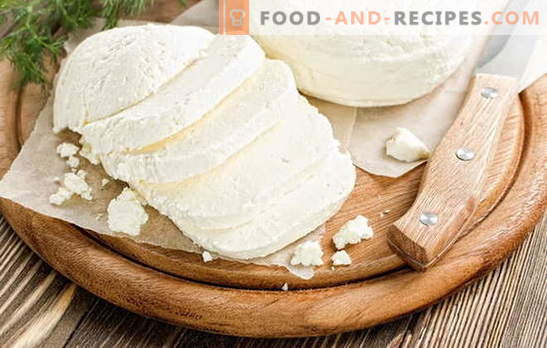
Adygei cheese has a lot of “relatives” in many countries: Mozzarella, cheese, Ricotta, Feta, Paneer and many other types of pickled cheese, invented in the whole history of mankind.
The Adyghe legend says that the famous cheese existed in the 7-8 millennium BC. But the cheese called “Adygei” became really famous only after the 1980 Olympics, in Moscow, where it was delivered in beautiful packages specially made in Finland.
The technology of production of brine cheese “Adygei” for thousands of years has not changed at all.
The only difference in modern production is the use of raw materials.
If earlier goat and sheep milk were used to make Adygei cheese, cow milk was used in the production because of the widespread and significant reduction in the livestock of these domestic animals.
However, after the introduction of this innovation, Adygea cheese makers began to actively spread rumors that they have special cows and give milk, which is not found anywhere in the world. By the way, about milk: in pasteurized form, the milk of the Adygei cow has no significant differences from the milk of an Indian or Swiss cow.
An interesting fact: the Adygei cheese is produced by many of the largest cheese-making enterprises in the CIS, but under a different name. The fact is that the name “Adygei cheese” was patented by manufacturers in the Republic of Adygea, therefore exactly the same cheeses made outside Adygea, with absolutely authentic taste should be called something else. But it's not the name, but the taste. Therefore, this cheese can be quite cooked in any home kitchen.
Adygei cheese at home - basic technological principles
The difference between the production technology of Adygei cheese from other pickled cheeses is that long-pasteurization is used for its production. The only difficulty in making Adygei cheese at home is to ensure long-term heating of the milk to a temperature of 95ºC, which affects the consistency of the clot. At the specified temperature, as well as in the process of continuous stirring, the milk protein is glued together in threadlike clots, pushing the whey mass.
So that the milk does not run away and does not burn during pasteurization, there is a simple and effective way to solve the problem: before heating, the raw materials should be cooled as much as possible, and then added to the pasteurization pan gradually, in small portions, with continuous stirring, pouring cooled milk along the edge of the container while lowering pan temperature and raw materials.
To prevent the milk from burning, before starting the baking of the cheese dough, pour some water into the bottom of the pan, and, bringing it to a boil, begin to add fresh milk first, and then whey, sour cream or sour milk. The use of fermented milk products in the preparation of homemade pickled cheeses is the best option. These products are naturally saturated with the necessary bacteria and enzymes and how to handle them properly, every housewife knows.
Special and rennet enzymes and starters, which are used in the production of cheese making, require a certain level of preparation from the novice cheese maker, and, in addition, their use makes sense for impressive volumes of cheese production: special starter cultures in the amount of 1.5-2 g are added to 100 liters of milk . At home, it is unlikely that anyone will need that amount of cheese: from 100 liters of milk, you can get 13-16 kg of product, depending on the type of milk. With such a minimum amount of starter per 100 liters, it will be very difficult to measure its weight for cooking a single cheese head weighing 1.5 kg.
It should be noted that the heads of smaller weight can be prepared at home, but the following factor should be taken into account: the separation of whey in brine cheeses occurs naturally, without the use of presses, under pressure of its own weight of the product. Therefore, based on the laws of physics, with a head weight of 0.5 kg, the process of squeezing the serum will be slower and less effective. The ratio of fresh milk and dairy products - 2: 1. It will be very convenient if, immediately prior to the start of preparation, to part a portion of fresh milk to dilute sour cream or thick yogurt: this will allow the sour mass to be poured more evenly and avoid the formation of lumps in the cheese dough.
In order to start making Adygei cheese at home, it remains to consider the requirements for the quality of the raw materials used and the standard requirements for the finished product. Of course, natural, whole milk is best suited for making cheese, which can be purchased from farmers or in specialized markets for agricultural products. Adygei cheese fat content is, according to standard requirements, 45%; humidity - up to 60%; salt content - 2%.
To get cheese of exactly this quality, the dairy raw materials used for its preparation should correspond to these indicators to the maximum. It is allowed to use dry concentrates, with the help of which natural skimmed milk can be brought to the desired fat content. Also, to obtain the necessary fat content, it is possible to use a combination of skimmed milk and fat sour cream.
In general, in their own kitchen, the rules of GOST do not have absolute power, but you can give free rein to your creative potential.
1. The original recipe for Adyghe cheese at home
Ingredients:
Goat milk, whole 4.5 l
Cow milk, whole 5.5 l
Whey, natural (from cow's, whole milk) 4 L
Salt
Cooking Method:
Take two types of milk in equal parts and the same amount of whey. For the preparation of brine cheese according to the original recipe, an enameled or stainless pan, 2 times the amount of milk, is needed.
Pre-filter milk purchased on the market through gauze or linen napkin.
Pour the milk into the pan, turning on the stove at the lowest temperature. Boil it for 50-60 minutes, infusing whey in small portions each time the milk is about to boil. Stir the contents of the pot continuously. In the dairy mass should form filamentous clots, separated from the serum. When the coagulated milk protein is collected in a globular clot, turn off the heat or remove the pan from the stove. Prepare a container for tilting the cheese, and put another bowl under it, into which the whey will drain. When the whey is drained and the cheese is compacted under its own weight, turn the mold over and place the head on the grid.
This Adyghe cheese is filtered through wicker wicker baskets. But you can use other suitable containers for this purpose: a sieve or a colander will do. Sprinkle the surface of the head with salt. The cheese should ripen within 18-24 hours. Cheese can be stored in tightly closed packaging, no more than 72 hours.
Recipe 2. Adygea cheese at home from a dry concentrate
Ingredients:
Milk, whole (3,2%) 6,5 l
Sour milk, homemade 3.3 l
Powdered milk (25%) 1.5 kg
Salt
Cooking:
Preheat the natural milk to 40ºC, and dissolve the dry concentrate in it, adding the powder with continuous stirring. When the concentrate is completely dissolved, separate 2.5-3 liters of milk from the total volume and cool this part to 18-20ºC.
Heat the second part of the reconstituted milk to 90-95ºC and begin to pour 200-300 ml of chilled milk into it first, and then yogurt to lower the boiling point. Use clabber with a temperature of + 5ºC to extend the cheese cooking process to an hour.
Pour in cooled milk and clabber on the edge of the pan, in circular motions, so that the clot collects in the center of the pan. Remove the pan from the stove when the milk is curdled and cool again to room temperature. Collect the clot and transfer it to a prepared mold with openings for the flow of serum. Place the form in the dish that will serve as a tray. After the cheese is compacted, salt the surface and put it on a grid or grate, and salt the cheese on the other side. Put the finished head in a plastic bag with a clasp or in a container with a tight-fitting lid. The shelf life of cheese is 3 days, at a temperature of 0-5ºC.
3. Adygei cheese at home from whole cottage cheese and milk
Ingredients:
Milk, whole 4.5 l
Cottage cheese, homemade (fat)
Cooking:
Rub the cottage cheese through a sieve and combine with half of the taken milk into a homogeneous mass, without lumps. The second half of cold milk, start to warm up in a saucepan, in parts of 200-300 ml: heating one part to 90ºC, pour in the next portion of milk. After all the milk has been pasteurized, start pouring in the cooled mixture of milk and curd, also in parts: in a circular motion, from the walls of the pan to the center. Remove the coagulated milk proteins from the stove for cooling. Next, form the cheese heads, as described in the recipes above.
4. Adygei cheese at home from milk and sour cream
Ingredients:
Natural milk 7.5 l
Sour cream (25%) 2.5 kg
Cooking:
Also, as in previous recipes, use the chilled ingredients to make cheese. Combine 1/3 part of milk with sour cream to get a homogeneous liquid mass: it will be convenient to introduce sour cream in a saucepan.
Begin to pasteurize the milk, pouring it in parts into a saucepan and warming it, close to the boiling point. In this case, the milk in no case should not boil. After all the milk has been poured in, pour in sour cream diluted with milk. During the pasteurization process, do not stop the smooth mixing of the cheese mass. Leave the coagulated milk protein to cool; Collect the curd in a sieve, colander or other round container with holes. After the separated whey is drained to the pallet and the cheese is compacted under its own weight, salt the surface and turn the mold over by placing the cheese in a prepared container for storage.
Adyghe cheese at home - tips and tricks
- For convenience of cooking Adyghe cheese at home, use a thermometer to monitor the pasteurization temperature of the milk: if the milk boils, the cheese will not work out, and the pasteurization temperature is very close to the boiling point.
- For the production of one kilogram of Adyghe cheese at home, at least 6.5 liters of milk is required.
- It is possible to replace rennet enzymes in home-made cheese with sour cream, cottage cheese, yogurt and any dairy products.
- If the household has a domestic smokehouse, try smoked Adygei cheese: having prepared the cheese head in any of the ways described, keep it in the smokehouse for 3-4 hours, in cold smoking mode (up to 25ºC). To smoke, brush the head of the cheese with butter. Smoking does not prolong the shelf life of cheese, but allows you to get new, interesting flavors. To increase the shelf life of smoked Adyghe cheese requires a longer exposure to the smokehouse, but this significantly changes the taste of the cheese.
- Try making Adygei cheese with pepper, cumin, cilantro or other spices and spices. This cheese can be used to prepare original salads and other dishes.
